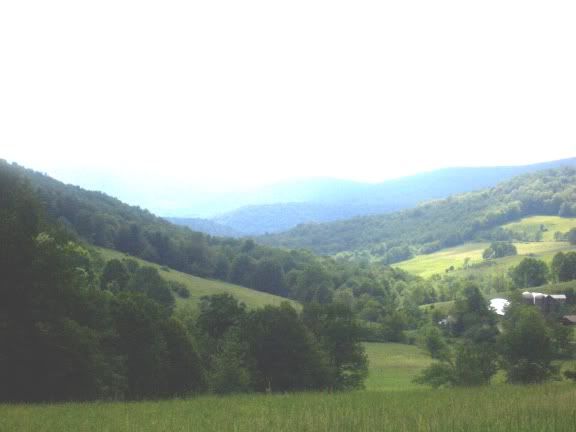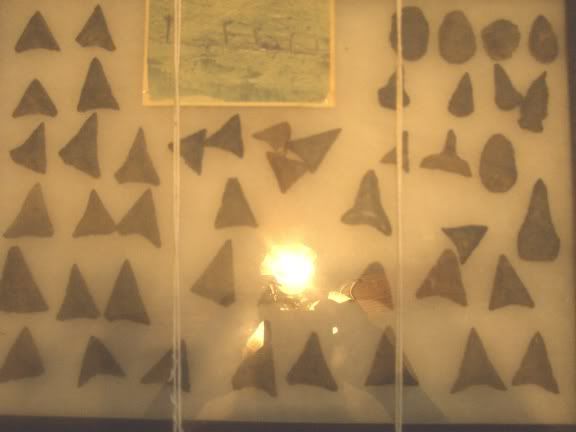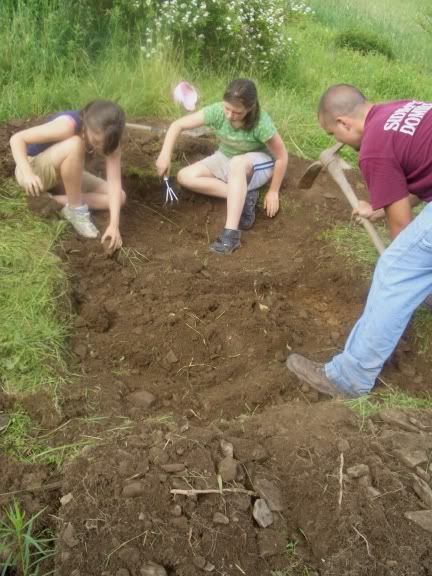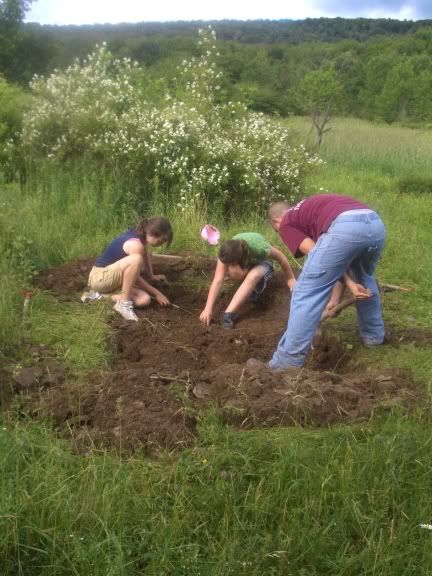
In the mid-1980s, I lived and worked in Delaware County in upstate New York. My office was one of a number of "human service agencies" that were located outside of a tiny hamlet, about ten miles from the county seat, due to space issues. In the summer months, when we would have our lunches on a few picnic tables that faced the upper Delaware River, a few of us used to discuss the local archaeological history. Over a couple of summers, I would point out a mountain on the other side of the river, and say that I thought there would be a settlement there, in part because of the extensive view the mountaintop afforded. Finally, three of us decided to see if we could get the land-owners permission to look around.
To find the spot, we had to take a curious route, first off of a county highway, then off a town road, and follow an isolated dirt road to its end. When we introduced ourselves to the elderly farmer who owned the land, he recognized my last name. By chance, a close relative of his had been one of the victims of a terrible double murder a few years before, and my uncle had solved the case within 36 hours, tracing the three murders half way across the country. Based upon his respect for my uncle, he said that he could actually show us the site we were looking for because in the summer of 1963, while bulldozing some brush up on the mountain, he had uncovered it. He also showed us the extensive collection that his family had: hundreds of Levanna arrowheads, drills, scrapers, pottery shards, two clay trumpet pipes, and a stone tube pipe (which he always carried with him).

For two summers, we did some excavating one the site. I brought a friend from a local university, and he had his students do a floatation test on a few samples from a fire pit. These tests confirmed what we already suspected: that the people living at the site consumed white-tail deer and turkey, among other things. Also, based upon the artifacts collected from the site (including the owners and what we found), there were very few that could be associated with cultivation. Thus, it appeared that the site was a seasonally occupied camp, where a primary focus was on the production of projectile points and, because of the high number of scrapers, on making the shafts for the arrowheads. The site, which had been visited by NYS Archaeologist William Ritchie briefly in 1965, was considered to fit into the Owasco cultural tradition (Ritchie included three phases in this tradition: Carpenter Brook, Canandaigua, and Castle Creek, in that order).
Late Monday morning, my younger son stopped by to see me. As he and his brother are working on a book about my studies of the archaeological, historical and oral history of Native Americans in our region no small topic he said that should visit one of the sites they were writing about. My daughters asked if it would be possible to go to a site where they could do some excavating. I called the phone number of the old farmer, not knowing if it was still in service. His wife answered, and said that my children and I were welcome to go up on the mountain.
I also spoke with one of her sons, who said that his mother now very, very old suffered from dementia, and that it was unlikely that she would remember talking to me by the time we arrived. My daughters found this sad, and so they had my son stop so that they could buy flowers and a pie for the elderly woman. When we finally arrived, three of her children (all in their 60s and 70s), were at their mothers house. They were pleased that my daughters had brought the gifts, and knowing the familys interest in Irish history, I gave them a copy of my first book.

As is common with Owasco sites, although it is located at a high elevation, it is also on the border of a large marsh. The water on the main part of the site was up over my ankles, and so we decided to start with some test pits a distance away. One son said that noone had every found any signs of occupation there; however, I believed that the site is more expansive than they realized. The first three test pits all turned up flint flakes, indicating that a good amount of chipping of points took place there.
Between Monday afternoon and Tuesday, we made a 9-by-9 foot square (the total of the 3-by-3 squares), and as the soil was relatively dry, we were able to go approximately 7 inches deep. In the 1960s, the federal government had lent support for small farmers to engage in land reclamation hence the bulldozing of brush and bulldozing tends to compromise the integrity of a site, but I still had my notebook, and kept records of what the kids found, and where. In total, they found one whole Levanna point; 26 broken points (bases and tips); two preforms, or blanks; two knives; two "strike-a-lights"; a broken pendant; and 23 scrapers, primarily the diagnostic "thumbnail scrapers" associated with the Owasco. Also, they collected over 1000 flint chips.

Of course, in the past decade or so, some archaeologists in our state have been challenging some of Ritchies theories. This is a good thing, although I do not think that there is good reason to discount his ideas. Build on them, adjust, and consider alternatives yes, of course. In Snows 1994 book "The Iroquois," he questioned the concept of the Owasco tradition as supporting the Iroquois in situ concept of development. He based that, in large part, on his interpretation of ceramics, along with his opinion that matriarchal cultures are associated with land acquisition through violence. Hence, I prefer Ritchie.
Also, in Issue 62 of the Northeast Anthropology abstracts (2001), Gates St. Pierre wrote that Ritchies Hunters Home phase (closely related to Owasco) was "an artificial construct" that confused the "simple intrusion of Owasco vessels into Point Penninsula components." Further, in their 2002 "The Death of Owasco," Hunt and Brumbach question if there is reason to use Ritchies concept of the Owasco tradition, at all. They, too, rely largely upon the interpretation of ceramics to support their position. Both of these papers also use Snow as a primary source. Still, I find their ideas to be interesting, and worthy of serious study.
From my previous work on attempting to find "common ground" between the interpretations of the archaeological record, with the oral traditions that Onondaga Chief Paul Waterman taught me, I found myself thinking about what the university professor and I spoke about two decades ago, while on this site. He was interested in having me assist him in documenting the village and camp sites between the Delaware and Susquehanna Rivers, from the general period of 700 to 1500 AD. That would include looking at the "established" museum and historical society collections, as well as as much information as we could gather from "amateur" archaeologists collctions, and from farmers, such as this land-owner. His duties ended up taking him to Asia for extended periods, however, and I eventually relocated to a different county. However, in the local three county area, Im familiar with two other significant Hunters Home and Owasco sites (both studied extensively by the state, though without the access to "amateur" collections that I have). Also, I had spent six years excavating a rock shelter on a local mountain, that had three distinct occupation levels, including a "Hunters Home" at the top level, with material that is clearly from the White Site.
Thus, my plans at this point are to spend the next week writing up a report on the section my kids excavated, and to try to examine and identify the numerous flint types that the artifacts and 1000 chips represent. It was rather fun taking the trip back twenty years, to when I first became acquainted with the site. And now I can go back even further.
